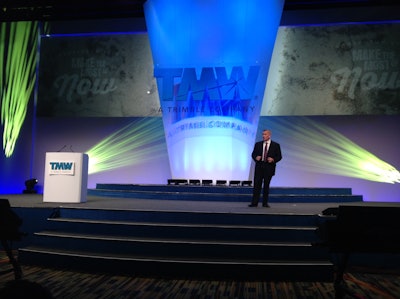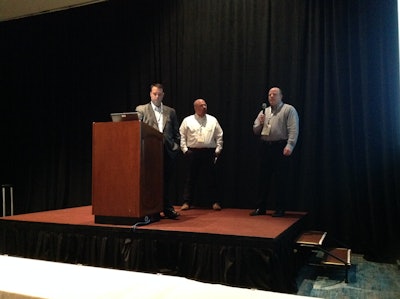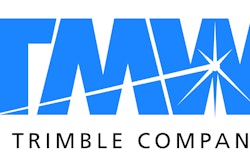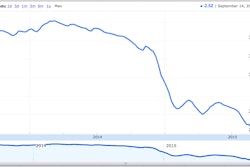
Perhaps it all stems from a renewed pride in America’s manufacturing heritage or nostalgia for life on a rural family farm, Wangler surmised. Whatever its cause, the movement he defined as “a blend of computer hacker culture with the skills of traditional craftsmen and inventors, designers and tinkerers.”
TMW Systems and parent company Trimble understand this “because that’s what we do, day-in and day-out,” said Wangler, who is president of the transportation management software provider. He was not just talking about making software, however.
“It’s easy sometimes for people to pigeonhole transportation as just a service industry, like real-estate or accounting. Because we don’t make anything, right?” he asked.
“Yet nothing could be further from the truth,” he continued. “We are an industry that makes the most of time. And time is one of the most precious commodities for any company.”
Time for business intelligence
In one of the 300 classroom sessions held at the event, an attendee lamented about the time he spends creating reports for his employer, a 150-truck bulk carrier based in Utah. It takes about six hours a week to pull information from separate databases to create custom spreadsheets, he said.
“I just need better analytics,” he admitted. He would like to start using a business intelligence (BI) tool called TMW Data Warehouse Explorer. The attendee — who wished to remain anonymous — told CCJ the tool could probably save him at least five hours per week.
In a sense, BI is a movement of its own to save time and focus company resources on opportunities. In general, transportation management systems (TMS) have evolved from digitized filing cabinets into big data analytical platforms.
As a large and diversified software provider, TMW Systems wants to seize the opportunity to deliver greater volume, variety and velocity of information to customers. The clear message at the conference was the expansion of its BI offerings.
“We are embarking on a journey to create an entirely new realm of possibilities driven by data,” Wangler said.
Big data platform
TMW is mapping out new opportunities to address customer needs with its Data Warehouse Explorer and other tools.
 Tim Leonard, chief technology officer of TMW Systems
Tim Leonard, chief technology officer of TMW SystemsThe effort is led by a new chief technology officer, Tim Leonard, who recently joined the company with 30 years of experience in big data analytics that included being an IT executive for General Motors.
The company has created a Value Engineering group that works with customers to assess their current analytical state and to design road maps for utilizing Data Warehouse Explorer to reach greater levels of analytical maturity, Leonard said.
TMW Systems is also building a big data analytics platform specifically for transportation.
“Analytics by itself won’t drive anything. It’s the data that really fuels the capability with various maturity levels of analytics itself,” he said. “In the future we are going to evolve the methods and capabilities of how you drive data.”
Its new “vertical analytics” platform will be able to predict certain behaviors within the industry by using the structured data in TMW’s product databases and those from third party systems. It will also be using unstructured data from external sources like driver messages and social media.
Another source of data will be from its own user community. Customers will be able to supply data anonymously for industry benchmarking. At present, the community data is collected with surveys but TMW is working to automate the capture of key operating metrics directly from customers who choose to participate.
“We want to build a community where you can safely contribute and benefit from the data generated by all of its members,” Wangler said. This effort will provide “deep insight” into what the overall market is experiencing in terms of both key performance indicators (KPIs) and the key operating indicators (KOIs) that drive them, he said.
Generating a return
Large carriers are most likely to be interested in the new business intelligence offerings and data community, but TMW says that carriers of all sizes can benefit.
 IT executives from USA Truck talked about how the company has implemented TMW business intelligence during the user conference
IT executives from USA Truck talked about how the company has implemented TMW business intelligence during the user conferenceUSA Truck, a 2,000-truck carrier based in VanBuren, Ark., is using several optimization and business intelligence tools from TMW. The company has worked with Value Engineering to implement products to reduce its operational costs.
For the past few months the company has been using Data Warehouse Explorer with Visual Analytics. The latter application presents metrics in custom dashboards and worksheets called “storyboards.”
“The metrics on the storyboard allows (executives) to see everything that is important in a very succinct method,” said Chris Rhoades, the company’s chief information officer. The business intelligence tools have helped the company invest its time and resources to optimize results, he added.
Chuck Radke, operations manager for H&M Trucking, a 200-truck dry van and bulk carrier based in Omaha, Neb., says the return on investment from big data analytics could be difficult to quantify for small carriers.
“How is a small carrier going to be able to afford to grab all this data and support it, both the infrastructure and the human side of it, and be able to spread it among the change phase?” he asked. “When you only have 150-200 trucks you can’t make drastic decisions for the ROI. It takes so much longer.”
Small carriers like his do not have the manpower to assign a new full or part-time position for big data analysis, he said. “You can’t afford to run the analytics constantly because you take away from the focus of the business. It takes so much longer for the smaller carrier to get the ROI.”
Radke suggested another reason why small carriers might be slow to adopt the big data platform. Their owners and executives are involved in the sales process, which is not always driven solely by data.
“The overall judging of which lanes are profitable still takes human input,” he said. “You can’t just rely on numbers. Big companies rely on numbers, and then they have to give business back. Once I commit to something we are committed to it.”
Small companies often operate multiple lines of asset and non-asset transportation businesses, however, and use various software systems. Other small carriers CCJ spoke with at the event expressed interest in using Data Warehouse Explorer and other tools to pull information together to have company-wide visibility to make better strategic and tactical decisions.











